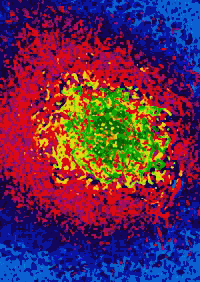Collaborative research between scientists at the London Centre for Nanotechnology, The University of Chicago, and the Center for Nanoscale Materials (CNM) at Argonne, using x-rays from the Argonne Advanced Photon Source (APS), has led to a major breakthrough in the understanding of antiferromagnets by revealing the internal workings of these materials for the first time.
Unlike conventional magnets, antiferromagnets (such as the metal chromium) are materials which exhibit “secret’ magnetism, undetectable at a macroscopic level. Instead, their magnetism is confined to very small regions where atoms behave as tiny magnets. They spontaneously align themselves opposite to adjacent atoms, leaving the material magnetically neutral overall.
"People have been familiar with ferromagnets for hundreds of years and they have countless everyday uses; everything from driving electrical motors to storing information on hard disk drives,” said Gabriel Aeppli, Director of the London Centre for Nanotechnology. “We haven't been able to make the same strides with antiferromagnets because we weren't able to look inside them and see how they were ordered.
"This breakthrough takes our understanding of the internal dynamics of antiferromagnets to where we were 90 years ago with ferromagnets. Once you can see something, it makes it that much easier to start engineering it."
The magnetic characteristics of ferromagnets have been studied by scientists since Greek antiquity, enabling them to build up a detailed picture of the regions - or "magnetic domains" - into which they are divided. However, antiferromagnets remained a mystery because their internal structure was too fine to be measured.
The internal order of antiferromagnets is on the same scale as the wavelength of x-rays (below 10 nanometers). The latest research used x-ray photon correlation spectroscopy at beamlines 33-ID (XOR/UNI) and 8-ID (XOR) of the Argonne Advanced Photon Source to produce “speckle” patterns: holograms that provide a unique “fingerprint” of a particular magnetic domain configuration.
Eric D. Isaacs, Director of the Argonne CNM, said: “Since the discovery of x-rays over 100 years ago, it has been the dream of scientists and engineers to use them to make holographic images of moving objects, such as magnetic domains, at the nanoscale.
"This has only become possible in the last few years with the availability of sources of coherent x-rays, such as the APS, and the future looks even brighter with the development over the next few years of fully coherent x-ray sources called free-electron lasers."
In addition to producing the first antiferromagnet holograms, the research also showed that their magnetic domains shift over time, even at the lowest of temperatures. The most likely explanation for this can be found in quantum mechanics, so the experiments open the door to the future exploitation of antiferromagnets in emerging technologies such as quantum computing.
"The key finding of our research provides information on the stability of domain walls in antiferromagnets," said Oleg Shpyrko, lead author on the publication and researcher at the CNM "Understanding this is the first step towards engineering antiferromagnets into useful nanoscale devices that exploit it."
Contact: O.G. Shpyrko, oshpyrko@anl.gov)
See: O. G. Shpyrko, E. D. Isaacs, J. M. Logan, Yejun Feng, G. Aeppli, R. Jaramillo, H. C. Kim, T. F. Rosenbaum, P. Zschack, M. Sprung, S. Narayanan, and A. R. Sandy; "Direct measurement of antiferromagnetic domain fluctuations," Nature 447, 68 (3 May 2007). DOI:10.1038/nature05776
The original news release can be found at: http://www.ucl.ac.uk/media/library/Secret_Magentism
Work at the London Centre for Nanotechnology was funded by a Royal Society Wolfson Research Merit Award and the Basic Technology program of Research Councils UK. Work at the CNM and the Advanced Photon Source was supported by the U.S. Department of Energy, Office of Science, Office of Basic Energy Sciences. The work at The University of Chicago was supported by the National Science Foundation.
Argonne is a U.S. Department of Energy laboratory managed by UChicago Argonne, LLC

